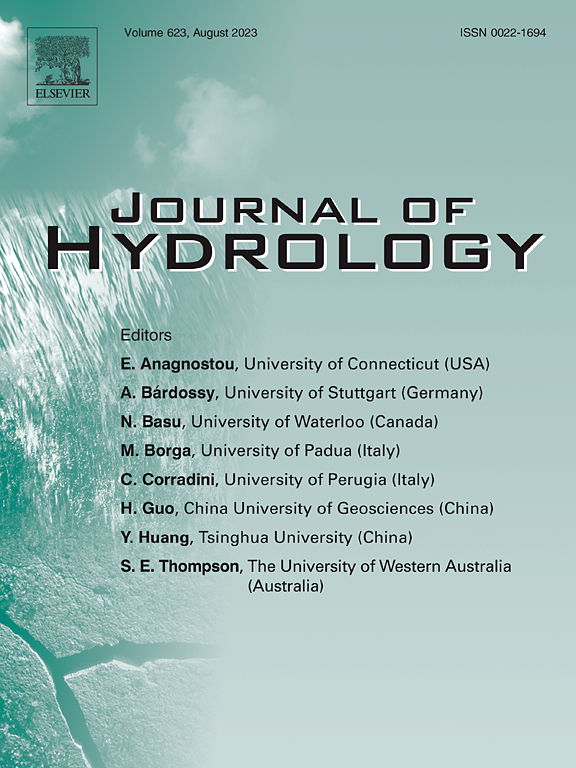Metamodeling of a physically based pesticide runoff model with a long short-term memory approach
IF 6.3
1区 地球科学
Q1 ENGINEERING, CIVIL
引用次数: 0
Abstract
Predicting the temporal variability in pesticide runoff from agricultural fields is essential for assessing the impacts of agricultural practices on surface water quality and the associated environmental risks. Richards-based models are valuable tools for this purpose, particularly in contexts characterized by high temporal variability in rainfall intensity, such as in the Mediterranean region. These methods can be applied to a wide range of operational applications at both the field and catchment scales. However, their operational capability is limited, primarily due to their high computation times. In this study, we assessed a metamodeling approach for a Richards-based model designed to simulate the hourly variability in water and pesticide runoff over a year while reducing computation times. The proposed approach is based on long short-term memory (LSTM) models and is applied to a field-scale pesticide runoff model coupling Richards and convection-dispersion equations with the uniform mixing cell concept for pesticide remobilization and an overland flow routine. The resulting metamodel accounts for meteorological conditions, compound properties, and pesticide application dates and rates. Although the LSTM architecture is not optimized, the metamodel reduces the computation time by 90% compared with that of the initial model. The metamodel shows high overall performance in simulating hourly discharges and pesticide concentrations, with Nash–Sutcliffe efficiency values of 0.99, confirming the ability of the LSTM models to handle hydrochemical time series. The results nonetheless indicate room for improvement in specific areas, such as simulating runoff occurrence or concentrations for compounds with low half-life values. Furthermore, the results encourage further consideration of adding static parameters as inputs to LSTM models to increase their generalizability. Overall, this study provides key insights for deploying methods to assess the impacts of agricultural practices on a large scale.
基于长短期记忆方法的农药径流物理模型元建模
预测农田农药径流的时间变化对于评估农业实践对地表水质量的影响和相关的环境风险至关重要。基于richards的模型是实现这一目的的宝贵工具,特别是在降雨强度具有高时间变异性的情况下,例如在地中海地区。这些方法可以应用于油田和集水区尺度的广泛业务应用。然而,它们的操作能力是有限的,主要是由于它们的高计算时间。在这项研究中,我们评估了一种基于richards的模型的元建模方法,该模型旨在模拟一年内水和农药径流的小时变化,同时减少计算时间。该方法基于长短期记忆(LSTM)模型,并将其应用于田间尺度的农药径流模型,该模型耦合Richards和对流-分散方程,并具有用于农药再动员的均匀混合单元概念和陆地流动程序。由此产生的元模型考虑了气象条件、化合物性质和农药施用日期和比率。虽然没有对LSTM体系结构进行优化,但与初始模型相比,该元模型的计算时间减少了90%。该元模型在模拟逐小时排放和农药浓度方面表现出较高的综合性能,Nash-Sutcliffe效率值为0.99,证实了LSTM模型处理水化学时间序列的能力。尽管如此,结果表明在某些特定领域还有改进的空间,例如模拟径流发生或低半衰期值化合物的浓度。此外,结果鼓励进一步考虑将静态参数作为LSTM模型的输入,以提高其泛化性。总的来说,这项研究为大规模部署评估农业实践影响的方法提供了关键见解。
本文章由计算机程序翻译,如有差异,请以英文原文为准。
求助全文
约1分钟内获得全文
求助全文
来源期刊

Journal of Hydrology
地学-地球科学综合
CiteScore
11.00
自引率
12.50%
发文量
1309
审稿时长
7.5 months
期刊介绍:
The Journal of Hydrology publishes original research papers and comprehensive reviews in all the subfields of the hydrological sciences including water based management and policy issues that impact on economics and society. These comprise, but are not limited to the physical, chemical, biogeochemical, stochastic and systems aspects of surface and groundwater hydrology, hydrometeorology and hydrogeology. Relevant topics incorporating the insights and methodologies of disciplines such as climatology, water resource systems, hydraulics, agrohydrology, geomorphology, soil science, instrumentation and remote sensing, civil and environmental engineering are included. Social science perspectives on hydrological problems such as resource and ecological economics, environmental sociology, psychology and behavioural science, management and policy analysis are also invited. Multi-and interdisciplinary analyses of hydrological problems are within scope. The science published in the Journal of Hydrology is relevant to catchment scales rather than exclusively to a local scale or site.
 求助内容:
求助内容: 应助结果提醒方式:
应助结果提醒方式:


